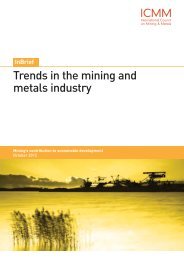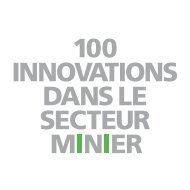Create successful ePaper yourself
Turn your PDF publications into a flip-book with our unique Google optimized e-Paper software.
and for different reasons. <strong>The</strong> steel<br />
industry <strong>has</strong> seen considerable<br />
vertical integration as producers drive<br />
for greater self-sufficiency of raw<br />
materials, either due to increasingly<br />
tight supply of inputs or increasing<br />
frustration with the major miners’<br />
ability to dictate price and pricing<br />
terms. This strategy seeks to reduce<br />
the market power of the major iron<br />
ore producers through decreased<br />
reliance on third-party suppliers.<br />
An example of this strategy is<br />
ArcelorMittal, which is significantly<br />
increasing its in-house iron ore and<br />
coal business as part of a strategy to<br />
double iron ore production to 100<br />
million tonnes per annum. Many<br />
other major steel companies have<br />
publicly stated their intentions to<br />
increase iron-ore and coking coal selfsufficiency;<br />
• Taiwan’s China Steel plans to<br />
increase iron ore self-sufficiency<br />
from 2% to 30% by 2015;<br />
• POSCO targets 50% raw material<br />
self sufficiency by 2014; and<br />
• Tata Steel plans to reach 100%<br />
iron ore and 50% coking coal selfsufficiency.<br />
While these stated desires are clear,<br />
only time will tell whether these<br />
companies, and others, are able to<br />
successfully and profitably deliver<br />
these strategies.<br />
Recent vertical integration <strong>has</strong><br />
also included end-users of mining<br />
products acquiring upstream assets.<br />
Many power producers, including<br />
Huadian of China and Tata Power of<br />
India, have made major coal mining<br />
acquisitions. Amongst zinc smelters,<br />
Nyrstar <strong>has</strong> been active in acquiring<br />
mining assets, including their <strong>2011</strong><br />
deal for Canada’s Farallon Mining,<br />
which increased its self-supplied<br />
zinc concentrate usage to 31%. This<br />
trend will likely also apply to traders<br />
as they increasingly look to build up<br />
upstream holdings, seen by Glencore<br />
in their run up to a potential IPO and<br />
China Minmetals in their acquisition<br />
of assets from Oz <strong>Mine</strong>rals and recent<br />
attempt for Equinox.<br />
We are beginning to see companies<br />
also look at other ways of achieving<br />
their integration objectives, such as<br />
combining strategic investment and<br />
off-take or partnership agreements<br />
to lower the risk associated with<br />
integration, but still reap similar<br />
benefits. A number of companies<br />
have adopted this approach, taking<br />
minority stakes or providing initial<br />
funding to major projects. Examples<br />
include China Railway’s 12.5%<br />
equity stake in African <strong>Mine</strong>rals with<br />
a 20 year off-take agreement and<br />
JFE Steel’s 20% investment in the<br />
Byerwen Coal project with a longterm<br />
off-take agreement.<br />
In contrast to other miners, Vale <strong>has</strong><br />
taken a 27% stake in the Brazilian<br />
steel production assets owned by<br />
ThyssenKrupp CSA. This equity<br />
investment is combined with an<br />
exclusive iron ore supply agreement,<br />
solidifying a domestic buyer for Vale’s<br />
Brazilian iron ore.<br />
Although vertical integration<br />
strategies vary amongst the miners,<br />
generally there is no desire to<br />
increase their presence in metals<br />
manufacturing or sales. Where<br />
integration <strong>has</strong> occurred, the focus<br />
is primarily on infrastructure assets,<br />
largely for the same motivation as<br />
described above – ensuring security<br />
of access to key production and<br />
transport needs. Vale, for example,<br />
is adding a number of bulk iron ore<br />
ships to their in-house fleet.<br />
Overall, trends in vertical integration<br />
reflect the changing nature of the<br />
industry, particularly as customers<br />
are becoming competitors to their<br />
current suppliers. For companies<br />
moving upstream in the quest for selfsufficiency,<br />
the mines being acquired<br />
are generally not Tier one assets and<br />
are usually in the development p<strong>has</strong>e.<br />
With the priority for new entrants<br />
often being security of supply, lower<br />
tier assets coming on-stream will shift<br />
the industry’s cost-curve.<br />
While traditional mining houses<br />
are not expected to vertically<br />
integrate downstream, many will<br />
likely continue to integrate into<br />
infrastructure. In metals, tightening<br />
supplies for raw materials and<br />
increasingly variable commodity<br />
prices will continue to drive<br />
producers upstream either through<br />
direct ownership and control or<br />
through minority ownership and<br />
strategic off-take agreements. In a<br />
supply constrained world, for many<br />
companies there is no alternative.<br />
What remains to be seen is whether<br />
vertical integration can deliver<br />
sustainable value and how the<br />
balance between miners, metals<br />
companies, and the markets they<br />
serve will change.<br />
<strong>Mine</strong>–<strong>The</strong> <strong>game</strong> <strong>has</strong> <strong>changed</strong> 19









